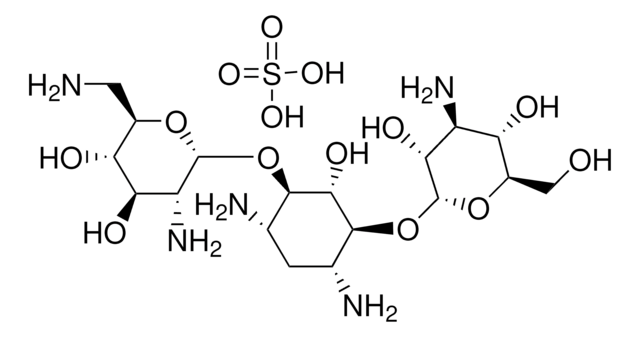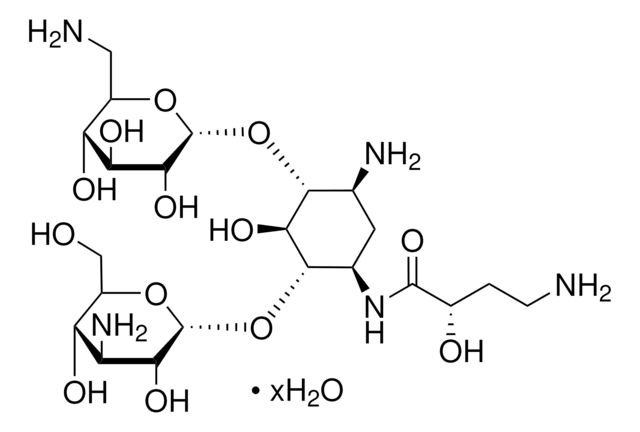K4000
Kanamicina
Animal Component-free
Sinonimo/i:
Kanamicina, Kanamicina A
About This Item
Prodotti consigliati
Origine biologica
Streptomyces kanamyceticus
Livello qualitativo
Stato
powder
Potenza
≥750 μg per mg (dry basis)
Colore
white to off-white
Solubilità
H2O: 50 mg/mL, clear, colorless to faintly yellow
Spettro attività antibiotica
Gram-negative bacteria
Gram-positive bacteria
mycobacteria
mycoplasma
Modalità d’azione
protein synthesis | interferes
Stringa SMILE
OS(O)(=O)=O.NC[C@H]1O[C@H](O[C@@H]2[C@@H](N)C[C@@H](N)[C@H](O[C@H]3O[C@H](CO)[C@@H](O)[C@H](N)[C@H]3O)[C@H]2O)[C@H](O)[C@@H](O)[C@@H]1O
InChI
1S/C18H36N4O11.H2O4S/c19-2-6-10(25)12(27)13(28)18(30-6)33-16-5(21)1-4(20)15(14(16)29)32-17-11(26)8(22)9(24)7(3-23)31-17;1-5(2,3)4/h4-18,23-29H,1-3,19-22H2;(H2,1,2,3,4)/t4-,5+,6-,7-,8+,9-,10-,11-,12+,13-,14-,15+,16-,17-,18-;/m1./s1
OOYGSFOGFJDDHP-KMCOLRRFSA-N
Cerchi prodotti simili? Visita Guida al confronto tra prodotti
Descrizione generale
Applicazioni
- in the research of bacterial antibiotic resistance
- in the research on the effect of different antibiotics on bud regeneration
Azioni biochim/fisiol
Modalità di resistenza: gli enzimi che modificano gli aminoglicosidi, inclusi acetiltransferasi, fosfotransferasi, nucleotidiltransferasi, possono alterare l′antibiotico, impedendogli di interagire con i ribosomi.
Spettro antimicrobico: La kanamicina solfato è efficace nei confronti dei batteri gram negativi e gram positivi e del micoplasma.
Caratteristiche e vantaggi
Nota sulla preparazione
Solutions are stable at 37°C for approximately 5 days. Aqueous stock solutions can be stored at 2-8°C for long term storage.
Stoccaggio e stabilità
Altre note
Prodotto comparabile
Avvertenze
Danger
Indicazioni di pericolo
Consigli di prudenza
Classi di pericolo
Repr. 1B
Codice della classe di stoccaggio
6.1C - Combustible acute toxic Cat.3 / toxic compounds or compounds which causing chronic effects
Classe di pericolosità dell'acqua (WGK)
WGK 2
Dispositivi di protezione individuale
Eyeshields, Gloves, type N95 (US)
Scegli una delle versioni più recenti:
Possiedi già questo prodotto?
I documenti relativi ai prodotti acquistati recentemente sono disponibili nell’Archivio dei documenti.
I clienti hanno visto anche
Articoli
Extraction and quantitative analysis of aminoglycosides in porcine tissue, using molecular imprinted polymer solid phase extraction followed by LC-MS/MS.
Il team dei nostri ricercatori vanta grande esperienza in tutte le aree della ricerca quali Life Science, scienza dei materiali, sintesi chimica, cromatografia, discipline analitiche, ecc..
Contatta l'Assistenza Tecnica.






